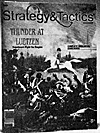
Designed by Bowen Simmons
TSR Inc. Dragon Publishing, P0. Box 110, Lake Geneva, WI 53147
Catalog No. Strategy & Tactics No. 99
Price: $6.00
Complexity: Intermediate
Solitaire Suitability: Moderate
***
Thunder At Luetzen is an operational level simulation of one of the crucial early engagements of Napoleon's 1813 campaign. Units represent leaders, artillery, French regiments and brigades, and Russo-Prussian regiments, brigades, and divisions. Although this game is a fine first effort for designer Bowen Simmons, its fastpaced approach to contact is followed by an intricate and frustrating battle phase.
Fortunately the numerous possibilities for maneuver featured in Thunder At Luetzen should ensure some replay interest.
The key to Simmons' Napoleonic vision lies in his concept of force "activity" combined with morale and leadership. Armies have a Morale Level determined by the number of corps in play, less expenditures for "active" corps and losses for game events such as combat results. Army commanders are able to "post" corps into Reserve, where they are unable to move or attack but may add to the Morale Level. Should the level reach zero, the army becomes demoralized and loses combat strength.
Using this overarching framework, Simmons then dispenses with the traditional movement and combat segments of a player turn. Rather, in Thunder At Luetzen both are integrated into a single Operations Phase. Individual units move and complete their attacks before the next unit is touched. In combat this results in successive attacks on defending units, which may be quite involved once substantial forces become engaged.
Combat is resolved using a strength differential results table, thus dispensing with the calculation of odds. All terrain effects are die roll modifiers. These provisions were doubtlessly crucial in a system where defenders are often attacked four, five, six, or more times in the course of an Operations Phase. While successive attack has some Napoleonic flavor, there is a cost in increased playing time. This could have been avoided by allowing limited stacking (say within the same division) plus a slightly different separation of differentials on the results table.
In fact the stacking rules are a little problematical in this game, which does not allow stacking at all. Hexes represent areas of 475 meters and units (all units are identical in numbers of men included) 2,500 infantry, 1,500 cavalry, or 40 guns. By way of comparison, at Waterloo, on a frontage of about 800 yards, French General Count d'Erlon committed 21,000 men and 46 guns.
Some stacking ability seems appropriate and would have reduced counter congestion when the armies in Thunder At Luetzen become closely engaged.
A specific criticism should be leveled at some of the unit strengths in this game, specifically artillery. At Luetzen the RussoPrussian army had 407 guns, the French 240. In Thunder At Luetzen the allies have 11 artillery factors, the French 47. At a more detailed level, with 136 guns Tormassovs corps qualifies for four artillery factors while, with 92 guns, Bluecher's Prussian corps has no artillery at all. On the French side meanwhile, MacDonald's XI Corps has five artillery factors for 48 guns.
While these features may not be satisfactory, what is nice about Thunder At Luetzen is the opportunity to maneuver. The different allied corps enter the game from eight "entry fields" selected in advance by the player, and which the French do not know. French entry points are fixed, but their reinforcements get accelerated as the allied army comes into action. A good degree of suspense is achieved.
The general system of maneuver has a few peculiarities of its own, however. Victory conditions focus on Morale Levels and on a hex on the side of the board opposite Luetzen itself.
Thus an actual recreation of the battle is less likely than in a focused battle game The Reserve rule allows corps to go inactive regardless of the tactical situation, so that corps holding the front can in fact be in Reserve. Indeed this kind of status is absolutely essential on night game turns to rebuild Morale Levels.
Thunder At Luetzen contains a number of novel design concepts-a worthy effort by Bowen Simmons. It is unfortunate that the design effort is marred by the obtuse elements that the game also contains. Napoleonic fans will like the new ideas, but general gamers may be turned off by the frustrations of battle.
More War Game Reviews
-
Game Review: Norway 1940: The Kriegsmarine Strikes
Game Review: Crusade in Europe
Game Review: Star Fleet Battles Supplement #2: X-Ships
Game Review: Thunder At Luetzen: Opening Battles for Germany 1813
Back to Table of Contents -- Game News #8
To Game News List of Issues
To MagWeb Master Magazine List
© Copyright 1985 by Dana Lombardy.
This article appears in MagWeb (Magazine Web) on the Internet World Wide Web.
Other military history articles and gaming articles are available at http://www.magweb.com